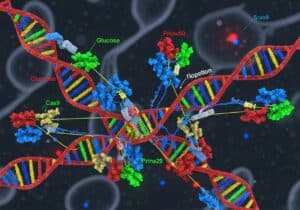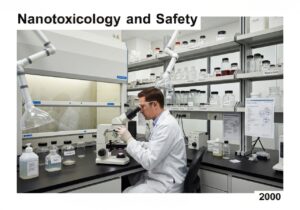
Synthetic biology integrates engineering principles with molecular biology to construct novel biological systems and redesign existing ones. Gene circuit design and genome editing techniques, including CRISPR-Cas systems, enable precise manipulation of genetic material. Metabolic pathway engineering optimizes biochemical production, while synthetic gene networks facilitate programmable cellular behavior. Advances in DNA synthesis and protein engineering expand functional capabilities. Cell-free synthetic biology platforms accelerate prototyping of genetic constructs. Biosensors and genetic toggle switches provide dynamic control and environmental responsiveness. Orthogonal ribosomes and synthetic promoters enhance specificity and modularity.
This is our latest selection of worldwide publications and patents in english on Synthetic Biology, between many scientific online journals, classified and focused on synthetic biology, gene circuit design, genome editing, CRISPR-Cas, metabolic pathway engineering, synthetic gene network, DNA synthesis, protein engineering, cell-free synthetic, biosensor, genetic toggle switch, orthogonal ribosome, minimal genome, synthetic promoters, RNA-based, metabolic flux analysis, directed evolution, synthetic chromosome, biobrick, genetic code expansion, computational synthetic biology, chassis organism, synthetic operon, gene expression modulation, synthetic transcription factor, biofoundries, metabolic engineering, synthetic biology automation, genetic part libraries, synthetic biology standard and biocontainment strategies.
The Role of Gene Therapy and RNA-Based Therapeutic Strategies in Diabetes
Published on 2025-10-22 by Mustafa Tariq Khan, Reem Emad Al-Dhaleai, Sarah M. Alayadhi, Zainab Alhalwachi, Alexandra E. Butler @MDPI
Abstract: Gene therapy and RNA (ribonucleic acid)-based therapeutic strategies have emerged as promising alternatives to conventional diabetes treatments, significantly expanding the therapeutic landscape using viral and non-viral vectors, and RNA modalities such as mRNA (messenger ribonucleic acid), siRNA (small interfering ribonucleic acid) and miRNA (micro ribonucleic acid). Recent advancements in these fields have led to notable preclinical successes and ongoing clinical trials, yet they are accompani[...]
Our summary: Gene therapy and RNA-based strategies are emerging as innovative alternatives for diabetes management. The review evaluates their mechanisms, efficacy, and safety concerns amid ongoing clinical trials. It highlights research gaps and future directions for personalized diabetes therapies.
Gene Therapy, RNA Therapeutics, Diabetes Treatment, Clinical Trials
Publication
Mechanisms and Research Perspectives in Mediating Insecticide Resistance
Published on 2025-10-20 by Qian Wang, Xuping Shentu, Xiaoping Yu, Yipeng Liu @MDPI
Abstract: Insecticide resistance has become a critical issue threatening global agricultural production and food security. Previous studies have primarily focused on resistance mechanisms such as target-site mutations, enhanced metabolic detoxification, and reduced cuticular penetration. However, growing evidence in recent years indicates that odorant-binding proteins (OBPs) and chemosensory proteins (CSPs)—beyond their roles in chemoreception—also play key roles in the develop[...]
Our summary: Insecticide resistance threatens global agriculture and food security. OBPs and CSPs play crucial roles in modulating insect susceptibility to insecticides. Future research should focus on multi-gene targeting and practical applications of these findings for sustainable pest control.
Insecticide resistance, Odorant-binding proteins, Chemosensory proteins, Metabolic detoxification
Publication
Rational Engineering of Patchoulene Synthase from Pogostemon cablin for Enhanced Patchoulene Production
Published on 2025-10-20 by Wei Ma, Xiukun Wan, Ge Yao, Fuli Wang, Hui Jiang @MDPI
Abstract: Patchoulene, the characteristic sesquiterpene of patchouli essential oil, is highly valued in the perfume industry for its distinctive woody note and fixative properties. Beyond its olfactory applications, patchoulene has demonstrated promising biological activities, including anti-inflammatory, antimicrobial, and neuroprotective effects. Current production relies mainly on extraction from Pogostemon cablin plants, which requires long growth cycles (≥8 months), exhibits low yields, an[...]
Our summary: This study enhances patchoulene production through rational engineering of patchoulene synthase from Pogostemon cablin. A semi-rational design approach identified key residues for catalytic activity, leading to the creation of mutant enzymes. The double mutant M2 exhibited a 3.62-fold increase in patchoulene yield, optimizing terpenoid synthase for sustainable production.
Patchoulene, Protein Engineering, Terpenoid Production, Mutagenesis
Publication
Therapeutic Potential of Modulating Gene-MicroRNA Crosstalk in Burn Injury
Published on 2025-10-16 by Dariya M. Badanina, Anastasia M. Bubnova, Dmitry S. Kozlov, Dmitry P. Krylov, Artem M. Mozherov, Massoud Vosough, Peter S. Timashev, Daria S. Kuznetsova @MDPI
Abstract: Burn injury represents a complex trauma involving numerous local and systemic pathological alterations, which are frequently exacerbated by the phenomenon of burn wound conversion or secondary deepening. Conventional clinical management relies heavily on the application of skin grafts, which primarily serve to provide temporary wound coverage and environmental isolation. However, such grafting procedures often prove insufficiently effective and fail to prevent the progression of the burn wound. [...]
Our summary: This review discusses the complex interactions between genes and microRNAs in burn wound healing. It highlights the limitations of current treatment methods and the potential of microRNA-based therapies. The focus is on innovative strategies to improve tissue repair and prevent complications associated with burn injuries.
Gene therapy, microRNA, burn injury, tissue regeneration
Publication
A Highly Sensitive Silicon Nanowire Array Field Effect Transistor Biosensor for Detecting HBV-DNA and AFP
Published on 2025-10-16 by Peng Sun, Mingbin Liu, Yongxin Zhang, Chaoran Liu, Xun Yang @MDPI
Abstract: Chronic hepatitis B poses a serious threat to human health and life, and early diagnosis is essential to improving patient cure rates. Hepatitis B virus (HBV) and Alpha-fetoprotein (AFP) are two key biomarkers for diagnosing chronic hepatitis B. In this study, we propose a silicon nanowire array field effect transistor (SiNW-array FET) biosensor that enables highly sensitive, real-time, and low-cost joint detection of both HBV and AFP. The SiNW-array FET is fabricated using traditional micro-nan[...]
Our summary: This study presents a silicon nanowire array field effect transistor biosensor for the sensitive detection of HBV-DNA and AFP. The biosensor demonstrates low detection limits and high specificity through chemical modification of the SiNWs. It shows promise for clinical applications in diagnosing chronic hepatitis B using serum samples.
biosensor, silicon nanowire, hepatitis B, detection
Publication
Virtual Screening of Cathelicidin-Derived Anticancer Peptides and Validation of Their Production in the Probiotic Limosilactobacillus fermentum KUB-D18 Using Genome-Scale Metabolic Modeling and Experimental Approaches
Published on 2025-10-16 by Vichugorn Wattayagorn, Taratorn Mansuwan, Krittapas Angkanawin, Chakkapan Sapkaew, Chomdao Sinthuvanich, Nisit Watthanasakphuban, Pramote Chumnanpuen @MDPI
Abstract: The development of anticancer peptides (ACPs) has emerged as a promising strategy in targeted cancer therapy due to their high specificity and therapeutic potential. Cathelicidin-derived antimicrobial peptides represent a particularly attractive class of ACPs, yet systematic evaluation of their anticancer activity remains limited. In this study, we conducted virtual screening of eight cathelicidin-derived peptides (AL-38, LL-37, RK-31, KS-30, KR-20, FK-16, FK-13, and KR-12) to assess their poten[...]
Our summary: This study performed virtual screening of cathelicidin-derived peptides for anticancer activity, identifying LL-37 and FK-16 as promising candidates. Limosilactobacillus fermentum KUB-D18 was utilized as a biosynthetic platform for peptide production, supported by genome-scale metabolic modeling. The experimental validation confirmed high yields and alignment with model predictions, demonstrating the effectiveness of this integrative approach for peptide therapeutics.
Anticancer peptides, Cathelicidin, Genome-scale metabolic modeling, Probiotic delivery
Publication
Engineering native e. coli for tumor imaging under hypoxia conditions
Patent published on the 2025-10-16 in WO under Ref WO2025217633 by UNIV OF FLORIDA RESEARCH FOUNDATION INCORPORATED [US] (Ding Yousong [us], Liu Dake [us])
Abstract: Escherichia coli is a widely studied model organism and an integral component of the human gut microbiome, offering significant potential for bacteria-based therapeutic applications. However, engineering native E. coli strains poses persistent challenges. In this study, the chassis- independent recombinase-assisted genome engineering technique was leveraged to engineer the native gut strain E. coli EcAZ-1 and the probiotic strain E. coli Nissle 1917 (EcN). The bioluminescent lux operon, green fl[...]
Our summary: This study engineered native E. coli strains for tumor imaging under hypoxia. The bioluminescent lux operon and fluorescent proteins were introduced to enhance imaging capabilities. Engineered strains also biosynthesize bioactive compounds, showcasing their potential in synthetic biology and therapeutics.
E. coli, tumor imaging, genome engineering, fluorescence
Patent
Biosensor for the in vivo monitoring of analytes
Patent published on the 2025-08-28 in WO under Ref WO2025178904 by RANAMUKHAARACHCHI SAHAN [AU] (Dervisevic Esma [au], Roshni Rita [au], Lin Fenge [au], Wang Kaixuan [au], Anderson Ryan E [us], Cadarso Busto Victor [au], Ranamukhaarachchi Sahan [au])
Abstract: A functional ion-selective sensor (ISS) is provided having an ion-selective membrane (ISM). The ISM includes an ion specific ionophore (I); a cation exchanger (CE) selected from the group consisting of: sodium tetraphenylborate (NaTPB), sodium tetrakis[3,5-bis(trifluoromethyl)phenyl]borate (NaTFPB), and potassium tetrakis(4-chlorophenyl)borate (KTCIPB); a base membrane polymer (BMP) comprising polyvinyl chloride (PVC) and/or polyurethane (PU), and a plasticiser (P) selected from the group consis[...]
Our summary: This content describes a functional ion-selective sensor designed for in vivo analyte monitoring. It details the composition of the ion-selective membrane, including specific ionophores, cation exchangers, and base membrane polymers. The document also specifies the weight percentage ranges for each component in the membrane formulation.
biosensor, ion-selective sensor, ion-selective membrane, in vivo monitoring
Patent














